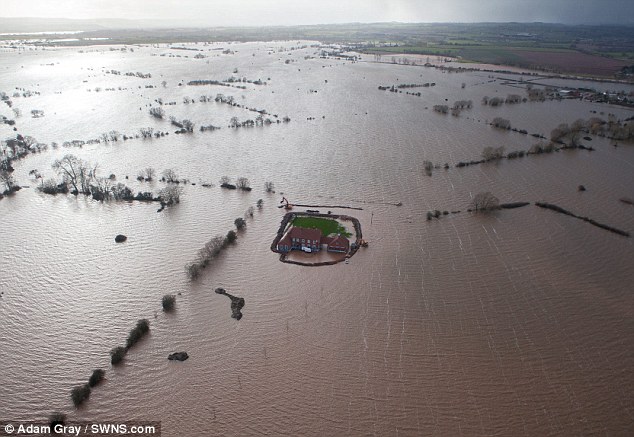Down below, entire squadrons of bulldozers and diggers are constructing a vast dam – a Hadrian’s Wall of mud – for mile after mile in order to prevent an enemy assault on nearby Bridgwater.The water has just swamped the main railway line outside the town, and a line has to be drawn somewhere.A little to the north, an 18-vehicle convoy of juggernauts has just arrived from Holland carrying one of the largest water pumps ever seen in the British Isles. Are we looking at D-Day – or Dunkirk?Either way, it has come too late for those villages and farms which are already in occupied territory. Yesterday, the waters on the Somerset Levels just carried on rising and a steady stream of tearful, angry residents continued to head for dry land, surrendering to the elements. With one exception.As of last night, Sam Notaro was still cheerfully holding out behind surely the most extraordinary piece of DIY since Noah’s Ark. Having recently built the house of his dreams for his young family, Sam has encircled his pride and joy with a six-foot wall of mud and rocks which has now featured in bulletins and newspapers around the world.And it was still getting higher as dusk fell yesterday evening. As I later discover, the whole thing might be considerably taller still had it not been for an executive at the Environment Agency who held things up for a day because Sam had not obtained the requisite permit for earth-moving. Is it any wonder the agency’s management is regarded with such contempt in these parts? Sam has been nicknamed ‘King Canute’, much to his amusement.But Canute famously ordered the waves to halt and failed. Sam, on the other hand, appears to be winning. I’d say he’s more like Churchill. He’s certainly fighting them on the beaches. Just don’t bring up the Dambusters here at Dyers Farm.From my helicopter cockpit, I can see the waves lapping at the top of his ramparts, while Sam and his father and a couple of friends take it in turns to scoop up more and more mud with a pair of increasingly submerged diggers. After weekend storms brought big waves crashing in from the west, they have even built themselves a new breakwater and outer wall. What are spirits like down inside this besieged little plot? It’s impossible to touch down because the garden is completely waterlogged and the helicopter pilot fears he could get bogged down. So I plot an amphibious landing. Working my way round to the outskirts of the drowned village of Moorland, I meet Sam as he comes ashore to pick up some more diesel for his water pumps. He’s from a big family of local builders and the whole lot have rallied round.Mum’s put together a few bags of supplies – pizzas, bread, tomatoes and a couple of bottles of wine. What he’d really like now, says Sam, is some fresh socks. ‘I haven’t felt dry for a week – and I do miss my babies,’ adds the 40-year-old father of two small girls.He moved them and his partner, Alana, to temporary digs last week. ‘I was feeling a bit down last night. It was like the North Sea coming straight at us and I thought the waves might break through. But we held out and we managed to get the second digger in today and that’s cheered me up.’As we prepare to set sail, a couple of his neighbours are coming ashore in a police rescue boat. ‘Goodbye, Sam. Don’t know when I’ll be back,’ says a lady called Lorraine, doing her best to put on a brave face. Her voice starts to crack as she explains that she’d only just installed a new kitchen. Sam offers his condolences. The whole area is in a state of bereavement. We set off in a boat skippered by Sam’s friend, Craig Fleming.A car dealer by trade, Craig has been helping out for a few days, staying up all the previous night to monitor the pumps so that Sam could grab some sleep.Poor Moorland is a dismal sight as we sail down the main road. Many people didn’t even manage to get their cars out in time. We turn towards Dyers Farm and the house is a truly surreal sight poking out of the sea – like Mont Saint-Michel with a four-bedroom executive home on top.When he started building this house four years ago, Sam worked out the highest point that flood waters had ever reached in these parts and then added on another foot. ‘I did apply to go three feet higher but the planning people wouldn’t have it.’ In some places beyond the wall, the water is now five feet over the ground and still climbing. Helicopter footage shows villages cut off by floods in SomersetWe moor at ‘the jetty’, a series of pallets laid over the dam. The photographer steps on to the mud and promptly goes up to his thigh in gloop. It’s not the easiest landing.Inside the stockade, there’s a couple of inches of water on the ground but the house itself has been completely sealed up with sandbags and polythene. ‘Would you mind taking off your boots?’ asks Sam as we reach the entrance. I assume he is joking but he isn’t. Inside, it is a very warm, very tidy, very clean and rather empty house. All the furniture, it turns out, has been carried upstairs. The paintings are still on the walls, as is a television. Over a cup of tea in the spacious kitchen, with its panoramic sea view beyond the dyke, Sam’s father, Joe, 62, vents his exasperation. The family are deeply appreciative of the efforts of two local Environment Agency officials, both called Steve, who have helped them bring in pumps and sandbags. ‘They’ve been brilliant. It’s the people at the top who drive us mad,’ says Joe. Setting aside the now unimpeachable arguments for dredging, he tells me how he had arranged for several lorryloads of earth and clay to come in here last Tuesday as soon as it was clear that the entire village was going to be submerged.‘Then the contractor called me and said that he couldn’t deliver the earth because Sam and I didn’t have a permit from the Environment Agency. I called the agency and was told I could be fined £30,000 if I didn’t get a permit.’ The permit – to ensure that the earth was not in any way contaminated – would take six to eight weeks to be processed.A day later, after a series of increasingly frantic calls to different parts of the agency, an official finally agreed to waive the demand for a permit. Joe’s lorries finally arrived and Sam could start work on his dam. ‘These officials just don’t have a clue,’ sighs Joe. ‘They’re more worried about wildlife. I love wildlife, too – I wouldn’t even kill a spider – but they need a businessman running that agency. Someone who gets things done.’Looking at the extraordinary earthworks taking shape around me, I suspect the agency could do with a Notaro or two, instead of the floundering Lord Smith. Between them, Sam and Joe have built their own mini-Netherlands in less than a week.Last night, Sam and his crew had another setback as one of his water pumps packed up. Today, if the floods are still rising, the diggers may have to leave before the water gets into the engines.‘But we’re still in with a chance,’ says Sam, adding that the locals are very grateful for all the support from the Mail and its readers. ‘We’re still fighting.’(dailymail.co.uk)ANN.Az
My house call on King Canute - PHOTO
World
18:45 | 11.02.2014

My house call on King Canute - PHOTO
Flying low over the ocean formerly known as Somerset, we come to the frontline of this epic battle. And this really is a battlefield.
Follow us !










